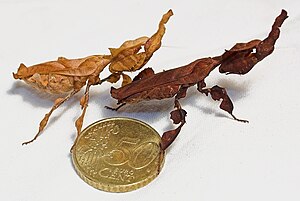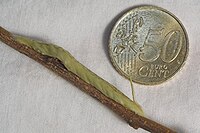Ghost mantis
| Ghost mantis | ||||||||||||
|---|---|---|---|---|---|---|---|---|---|---|---|---|

Ghost mantis ( Phyllocrania paradoxa ) |
||||||||||||
| Systematics | ||||||||||||
|
||||||||||||
| Scientific name | ||||||||||||
| Phyllocrania paradoxa | ||||||||||||
| Burmeister , 1838 |

The ghost mantis ( Phyllocrania paradoxa ) (plural: the mantis, English: "Ghost Mantis"), also called "withered leaf", is a species of insect from the Hymenopodidae family in the order of mantis (Mantodea). There are two subspecies of this species : in addition to the nominate form described in 1838, there is also Phyllocrania paradoxa insignis , which was discovered in 1871, but which is sometimes listed as a separate species. It is a small leaf-mimicking fishing insect that camouflages itself perfectly as a withered leaf ( mimetic ).
features
Particularly noticeable are the numerous appendages ( praises ) on the abdomen and legs, the pronounced neck shield (see illustration), and the high crown that the animals wear on their heads. The high mobility of the head, which can be rotated almost 180 degrees, as well as the laterally arranged eyes and the greatly elongated prothorax are also striking . The large, staggered eyes enable stereoscopic vision and represent the most important sensory organ for hunting and the precise localization of sexual partners. Between the antennas there are three pinpoint eyes ( ocelli ) with which the animals register differences in brightness (see illustration). The front pair of legs, as is usual with mantis to catch legs transformed, femur and tibia are covered with thorns to hold the prey. The fang legs, which are shifted far forward, act more like arms in these animals, as they can move freely and are very far away from the striding legs. As an imago , the animals have two pairs of wings, but the females are not able to fly because their wings are too small. The wing approaches can already be seen in the subadult stage. The cuticle of the animals is very rough and unevenly designed, and it also bears the colors and patterns of their living environment to be even better camouflaged. There are green, sand-colored, up to almost black animals.
Newly hatched larvae are about six to seven millimeters long. The adult animals reach a length of about 50 millimeters, with the female and male animals being almost the same size.
Reproduction
The sex of this species of fishing horror can be determined relatively easily from around the third larval stage, since the crown of the female runs straight from the head, while that of the male is characteristically curved. The antennae of the males are much thicker and longer than those of the female and the wings of the male are larger than those of the female, which is already visible in the subadult stage from the differently sized wing attachments. The praises, the neck shield and the muzzle legs of the males are significantly smaller than in the female, overall the body structure is somewhat more filigree than in the females, but this can also only be recognized in the later larval stages. The sexes also differ in each larval stage by the number of sternites , it is six in the females and eight in the males. The life expectancy of female Phyllocrania paradoxa is around 11 months, males live to be around 8 months. During this time the males molt six times and the females seven times. The females are ready to mate approx. 14 days after the imaginal moult, the males after approx. Seven days. One to five days after copulation , which lasts about three to six hours , the female lays about 10, three to five centimeters long, elongated, narrow, with an "antenna" provided egg packets ( ootheca ) at intervals of 6 to 12 days can be up to eight inches tall. Immediately after being laid, the oothecae are greenish, but they get darker over time, so that they are usually dark brown when hatched. Very old oothecs can be almost black. After about four weeks, 10 to 50 black larvae hatch from the ootheca, which are about six to seven millimeters long and resemble ants (ants mimicry ).
distribution
The species lives in East Africa , the Democratic Republic of the Congo , Angola , Namibia , South Africa and Zimbabwe . Their habitat are shrubs and bushes in dry areas.
photos
- Female animal
- Male animal
literature
- I. Bischoff, R. Bischoff, C. Hessler, M. Meyer: Mantiden. Fascinating ambulance hunters . 2nd Edition. Edition Chimaira, Frankfurt am Main 2006, ISBN 3-930612-45-3 , ( PraxisRatgeber ).
- Reinhard Ehrmann: Mantodea. Praying mantises of the world . NTV, Münster 2002, ISBN 3-931587-60-6 , ( NTV Wissenschaft ).
Individual evidence
- ↑ Otte, Daniel, Lauren Spearman and Martin BD Stiewe. Mantodea Species File Online. Version 1.0 / 3.5. (accessed on May 15, 2010)








